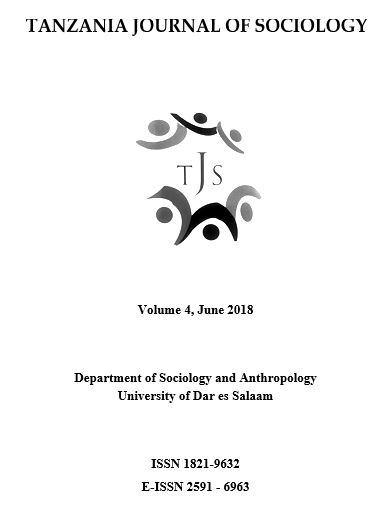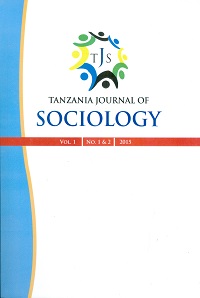Dancing With[out] Simmel
Abstract
In this article, I examine how actors stage colour-blind sociability to demonstrate racial integration in the presence of the audiences. I argue that social actors acquire sociability when expected to do so. My assertions are grounded in the ethnographic field work carried out in secondary schools in Dar es Salaam, and a thorough step by step analysis using grounded theory analysis. I have thus found that young people in secondary schools identify themselves on the basis of race groups, namely, African group, "Indian" [South Asian] group, Arab group and ' half-caste ' [biracial] group]. Also, students exhibit tendencies of exclusion across these groups. However, during the school events such as the parents ' day, the school authorities tactically bring together all race groups for joint performances. It is during such events that one may notice how the youngsters temporarily accommodate their differences through colour-blind sociability.
References
Bapumia, F. (2012). Rationalizing violence Domesticizing Abuse: South Asian Experience in Tanzania (1. Aufl.). Saarbrücken: LAP LAMBERT Academic Publishing.
Barth, F. (1969). Ethnic groups and boundaries: The social organization of culture difference. Prospect Heights: Waveland Press.
Barth, F. (1994). Enduring and Emerging issues in the analysis of ethnicity. In H. Vermeulen & C. Govers (Eds.), The anthropology of ethnicity. Beyond "Ethnic groups and boundaries" (pp. 11 €“32).
Amsterdam, Hague, Netherlands: Spinhuis.
Baumann, G. (1999). The multicultural riddle: Rethinking national, ethnic, and religious identities. New York: Routledge
Bertz, N. (2015). Diaspora and Nation in the Indian Ocean: Transnational Histories of Race and Urban Space in Tanzania: University of Hawaiʻi Press.
Bharati, A. (1972). The Asians in East Africa: Jayhind and Uhuru. Professional-Technical Series. Chicago: Nelson-Hall.
Brennan, J. R. (2012). Taifa: Making nation and race in urban Tanzania. Athens: Ohio University Press.
Costa, X. (2001). Festivity: Traditional and modern forms of sociability. Social compass, 48(4), 541 €“548.
Mesaki, S., & Bapumia, F. (2015). The minorities of Indian origin in Tanzania. In M. Adam (Ed.), Indian Africa: Minorities of Indian-Pakistani origin in eastern Africa (pp. 349-360). Dar es Salaam: Mkuki na Nyota Publishers.
Nagar, R. (1997). The making of Hindu communal organizations, places, and identities in postcolonial Dar es Salaam. Environment and Planning D, 15, 707 €“730.
Nagar, R. (1998). Communal Discourses, Marriage, and the Politics of Gendered Social Boundaries among South Asian Immigrants in Tanzania. Gender, Place & Culture, 5(2), 117-139. https://doi.org/10.1080/09663699825241
Oonk, G. (2006). South Asians in East Africa (1800-1920) with a particular Focus on Zanzibar: Towards a Historical Explanation of Economic Success of a Middlemen Minority. African and Asian Studies, 5(1), 1 €“32.
Pollock, M. (2004) Colour Mute: Race talk Dillemas in an American School. Princeton: Princeton University Press.
Pyörälä, E. (1995). Comparing drinking cultures: Finnish and Spanish drinking stories in interviews with young adults. Acta Sociologica, 38(3), 217 €“229.
Rietdorf, U. (2003). Minderheiten und ihre Bedeutung für endogene Entwicklungen in Afrika. das Beispiel Tansania. Schriftenreihe Orbis. Hamburg: Kovač
Sanders, J. M. (2002). Ethnic boundaries and identity in plural societies. Annual review of sociology, 327 €“357.
Schiffrin, D. (1984). Jewish argument as sociability. Language in Society, 13(03), 311 €“335.
Schiller, N. G., Darieva, T., & Gruner-Dominic, S. (2014). Defining cosmopolitan sociability in transnational age. An introduction. In Cosmopolitan sociability: locating transnational religious and diasporic networks, pp. 1 €“20. Routledge.
Simmel, G. (1910). Soziologie der Geselligkeit. In Deutsche Gesellschaft für Soziologie (DGS) (Ed.), Verhandlungen des 1. Deutschen Soziologentages vom 19. bis 22. Oktober 1910 in Frankfurt am Main (pp. 1 €“16). Frankfurt am Main: Sauer u. Auvermann. Retrieved from http://nbn-resolving.de/urn:nbn:de:0168-ssoar-187880
Simmel, G., & Hughes, E. C. (1949). The Sociology of Sociability. American Journal of Sociology, 55(3), 254.
Toiskallio, K. (2000). Simmel hails a cab: Fleeting sociability in the urban taxi. Space and Culture, 3(6), 4 €“20.



